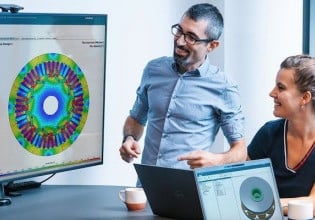The following is a listing (with links for the full story) of the most-read Industry News stories on PowerPulse.Net for 2015, thus providing a window into the "pulse" of the trends and interests in the Power Electronics Industry. This is the third article in the series, which will continue tomorrow.
#30: 260kW Motor reduces Weight 5X targets Electric Aircraft
Researchers at Siemens AG have developed a new type of electric motor that, with a weight of just 50 kilograms, delivers a continuous output of about 260kW, five times more than comparable drive systems. The motor has been specially designed for use in aircraft. Thanks to its record-setting power-to-weight ratio, larger aircraft with takeoff weights of up to two tons will now be able to use electric drives for the first time. To implement the world-record motor, Siemens' experts scrutinized all the components of previous motors and optimized them up to their technical limits. New simulation techniques and sophisticated lightweight construction enabled the drive system to achieve a unique weight-to-performance ratio of 5kW per kilogram. more
#29: New Packaging for More Powerful and Efficient Electronics
Following the launch of the 12th Electronics Packaging Research Consortium (EPRC12) in 2013, A*STAR's Institute of Microelectronics (IME) and 11 of its consortium partners across the semiconductor supply chain have developed novel solutions in integrated circuit (IC) packaging. The consortium has achieved its objectives of developing novel solutions to overcome the reliability and performance issues and technical challenges in packaging solutions for compact sized consumer electronics and high-power electronics. more
#28: SiC Railcar Traction Inverter Achieves 40% Power Savings
Mitsubishi Electric Corporation announced its main circuits featuring traction inverter made with all-silicon carbide (SiC), which were installed in a 1000 series urban train operated by Odakyu Electric Railway Co., Ltd. in Japan, have been verified to achieve an approximate 40-percent savings in power consumption compared to a train using conventional circuitry. The traction inverter, which is rated for 1,500Vdc catenaries, was tested over a four-month period. more
#27: Quantum Weirdness: Atoms only Exist when Measured
The bizarre nature of reality as laid out by quantum theory has survived another test, with scientists performing a famous experiment and proving that reality does not exist until it is measured. Physicists at The Australian National University (ANU) have conducted John Wheeler's delayed-choice thought experiment, which involves a moving object that is given the choice to act like a particle or a wave. Wheeler's experiment then asks - at which point does the object decide? more
#26: Transphorm and ON Semiconductor Co-Branding GaN Power Devices
Transphorm Inc. announced at APEC 2015, in partnership with ON Semiconductor, the introduction of two co-branded 600V GaN cascode transistors and a 240W reference design that utilizes them. This introduction builds on the previously announced partnership between Transphorm Inc., Transphorm Japan Inc., and ON Semiconductor to bring GaN-based power solutions to market. With typical on-resistances of 150 and 290 mOhms, the two new GaN products, TPH3202PS (ON Semi equivalent: NTP8G202N) and TPH3206PS (ON Semi equivalent: NTP8G206N), are offered in an optimized TO-220 package for easy integration with customers' existing circuit board manufacturing capabilities. more
#25: California's PV Incentive Program Claimed to be Suboptimal
Since 2007, California has had one of the most aggressive incentive programs in the country for putting solar-electric panels on the rooftops of homes and businesses. Its $2.2 billion California Solar Initiative (CSI) has provided a per-watt rebate for installing residential and commercial photovoltaic systems. During this period, the solar industry in the state has experienced double-digit growth and to date has installed more than 245,000 systems capable of producing 2,365 megawatts of electricity. more
#24: Iron Fluoride may Triple Capacity of Li-ion Batteries
In a move that could improve the energy storage of everything from portable electronics to electric microgrids, University of Wisconsin-Madison and Brookhaven National Laboratory researchers have developed a novel X-ray imaging technique to visualize and study the electrochemical reactions in lithium-ion rechargeable batteries containing a new type of material, iron fluoride. more
#23: Designing with 1200V SiC MOSFETs
Cree, Inc. has introduced a new design kit that includes all of the components needed to evaluate Cree® MOSFET and Schottky diode performance in a configurable half-bridge circuit. Quick and easy to assemble and use, the new design kit enables comparative testing between IGBTs and Cree MOSFETs, and provides an effective layout example for properly driving Cree MOSFETs with minimal ringing. Designed to assist engineers new to the higher switching speeds of SiC devices, the kit provides easy access to critical test points, enabling simple and accurate measurements, including VGS, VDS, and IDS. more
#22: Magnesium Batteries may Outperform Li-ions
Researchers at the University of Illinois at Chicago have taken a significant step toward the development of a battery that could outperform the lithium-ion technology used in electric cars such as the Chevy Volt. They have shown they can replace the lithium ions, each of which carries a single positive charge, with magnesium ions, which have a plus-two charge, in battery-like chemical reactions, using an electrode with a structure like those in many of today's devices. more
#21: Scientists create Quick-charging Hybrid Supercapacitors
The new hybrid supercapacitor developed at UCLA stores large amounts of energy, recharges quickly and can last for more than 10,000 recharge cycles. The dramatic rise of smartphones, tablets, laptops and other personal and portable electronics has brought battery technology to the forefront of electronics research. Even as devices have improved by leaps and bounds, the slow pace of battery development has held back technological progress. Researchers at UCLA's California NanoSystems Institute have successfully combined two nanomaterials to create a new energy storage medium that combines the best qualities of batteries and supercapacitors. more






